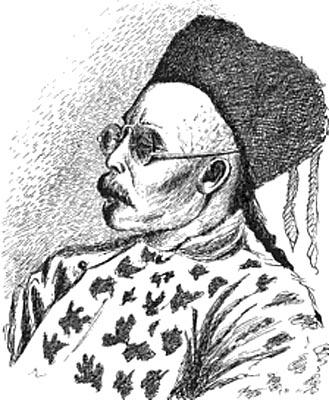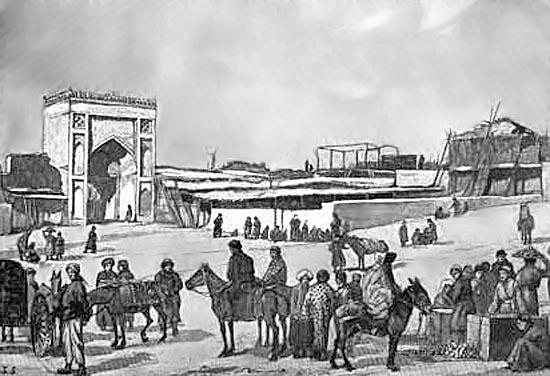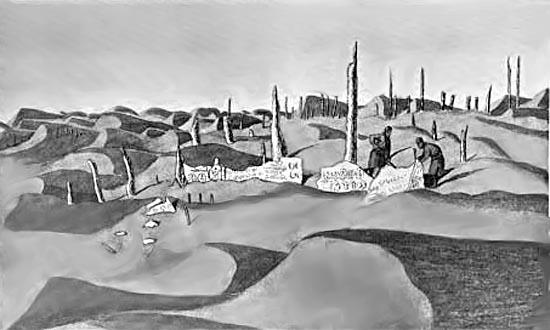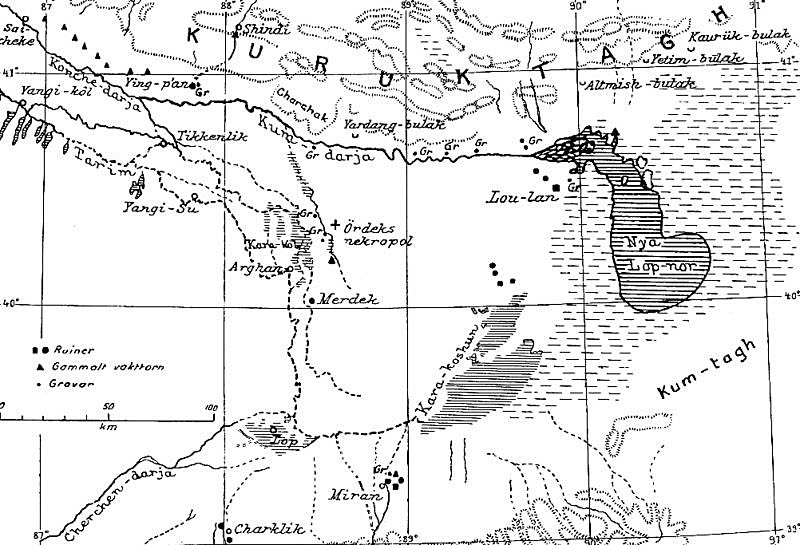|
|
|
Sven Hedin's Expeditions
1986 -1935
Google
Map 5
To view his route click on
Google Map 5
Kashgar-Khotan-Lopnor
Expedition
15
Jan - 27 May 1896
Kashgar 5
Dec 1895
Placemarker Sven Hedin's Lopnor Expedition
Kargalik
24 Dez 1895
We reached the town of Kargalik on Christmas Eve; but there was neither snow nor fir to recall the significance of the day. The people, however, showed us all the good-will that we are wont to associate with the holy season. We put up at the house of a merchant from Kokand, in Fergana, and in the evening he entertained me to a first- rate dastarkhan, embracing apples, pears, raisins, almonds, and divers kinds of sweetmeats, presented on a dozen dishes. It was like a Christmas table, except that everything was placed on the floor. A little later on the ten begs of the town came in Chinese holiday attire and pigtails to bid me welcome to Kargalik; and lastly, I received from the amban (Chinese governor), Li Darin, a number of useful presents, such as sheep, rice, wheat, maize meal, fuel, and forage for my horses. As soon as my guests were gone and my journal for the day had been written up, I hurried into bed to drown
The amban was an agreeable little old man of some fifty years of age, and of gentlemanly manners, with a small, gray, well-cared-for mustache, and big round spectacles. He invited me to stay to dinner with him. After dinner I sketched him; then to my astonishment in tripped his dainty young wife, on her tiny goat's- feet (scarcely two inches long), and in her turn begged me to make a sketch of her too; she wanted to send her likeness to her parents in Peking. I was, of course, only too happy to comply with such a flattering request.
I left Kargalik the next day, and the amban's courtesy went the
length of sending a beg to act as my escort and relieve me of all
trouble during the journey. The town possessed five gates, the same
number as Yarkand, and as we passed out of the eastern gate the
cannon again boomed forth a farewell salute.
Sven
Hedin, "Through Asia"
Guma
29 Dec 1895
|
|
|
Our next station was the pleasant little town
of Guma, an oasis in the desert well supplied with water. The route
between Chullak-lengher and Guma ran across dreary steppes and barren
plains. December 29th we spent at Guma, and the following day went on
to the village of Muji.
Sven
Hedin, "Through Asia"
Khotan1
6-14 Jan 1896

Liu
Darin the amban of Khotan
I stayed nine days in Khotan. The amban, Liu Darin, showed me genuine hospitality. The very day of my arrival we exchanged the usual visits of ceremony and gave one another presents. I went to see him many times afterwards, and soon discovered that even according to European ideas he was a man of honor—generous, upright, and just; and a real tie of friendship grew up between us. He was a man of seventy or so, tall, with strongly marked features, small, intelligent eyes, a thin white mustache, and a very meagre pigtail. Of all the Asiatics with whom I came in contact on this present journey, Liu Darin is the one I like best to remember, and whom it would give me greatest pleasure to see again.
On this occasion, as well as when I got back to Khotan the second time, Liu Darin often invited me to his house. There, in company with the chief mandarins of the town, I dined on delicacies which would have delighted even a European gourmand. Among the dishes which were never absent at his big dinners was soup made of the edible swallows' nests, which is remarkable for its aromatic flavor. I always looked forward to Liu Darin's good dinners as a change in my homely and monotonous bill of fare—rice, mutton, and bread. At Liu Darin's I ate like a Chinaman, and felt well after it; which is more than I can say of Dao Tai's dinners in Kashgar.

The
Registran of Khotan
In the 5th-10th cent AD Khotan had a large thriving community of Buddhist monks, described by several Chinese travelers (e.g., Fa Xien). It was destroyed by the Qarakhanid Qaghans after a long siege at the end of the 10th cent. It never recovered, in part because of the southern Silk Road having dried up.
Khotan is really the name of the entire oasis, embracing some three
hundred villages.There were two bazaar-days a week, when the
countryfolk came in with their produce for sale. The women also took
part in the trafficking, and even when sitting in the bazaars were
always unveiled. But they might just as well have kept their veils
before their faces, for they were indescribably ugly and dirty, and
covered with vermin, after which I often saw them unblushingly making
chase. As a rule veiled women were an exception. The moral standard
of the place was deplorably low, and infectious diseases very
common.
Sven
Hedin, "Through Asia"
Borasan
9 Jan 1896
|
|
|
Small terracotta votive objects found by SH in Borasan
On January 9th, 1896, I made an excursion to the village of Borasan,
about three miles west of Khotan, one of the most important sites in
Central Asia for the discovery of remarkable antiquities.
Sven
Hedin, "Through Asia"
"Taklamakan City"
24
Jan 1896

Ruins
of the ancient town of "Taklamakan"
On January 24th we left the camp to take care of itself, while, with the men travelling as usual on foot, and carrying spades and hatchets in their hands, I rode my camel bareback to the ruins, which were now in our immediate vicinity.
None of the other ruined sites I visited in East Turkestan resembled the curious remains we were now about to explore. As a rule the survivals of ancient towns in that region consist of walls and towers of sun-dried, or at least burned, clay. In Takla-makan, however, all the houses were built of wood (poplar); not a single trace of a stone or clay house was discernible. They were also constructed in quite a different way. Although the ground-plan in many respects resembled that of the modern houses, most of them were built in the shape of a small square or oblong within a larger one, and divided into several small rooms. The only portions that survived were posts six to ten feet high and pointed at the top, worn away by wind and sand, cracked and hard, but nevertheless as brittle as glass, breaking readily when struck.
There were hundreds of these ruined houses; but I was unable to make out the ground-plan of the city, nor could I trace the streets, bazaars, and squares, because the whole of the site, which occupies an extensive area from two to two and a half miles in diameter, was buried under high sand- dunes. The only houses which were visible above the all- engulfing ocean of sand were those that were built upon original rising ground, or now stand in the depressions between the sand-dunes.
In one of the buildings, which the men called Bud-khaneh (the Temple
of Buddha), the walls were still extant to the height of about three
feet. They consisted of kamish (reed) stalks tightly bound together
in small hard bundles and fastened to stakes, and were plastered with
a coating of clay mixed with chaff, making a tough, solid, and
durable building material. The walls, which were quite thin, were
plastered outside as well as inside, and were decorated with a number
of paintings, executed in a masterly manner. They represented female
figures, somewhat airily clad, kneeling with their hands folded as in
prayer. Their hair was twisted in a black knot on the top of the
head, and the eyebrows were traced in a continuous line, with a mark
above the root of the nose, after the fashion customary among the
Hindus of the present day. We also found pictures of men with black
beards and mustaches, in whom the Aryan type was clearly
distinguishable at the first glance; they were dressed in the same
manner as the modern Persians. Besides these, there were figures of
dogs and horses, and boats rocking on the waves—a strangely
impressive picture in the heart of the arid desert — ornaments,
running borders of ovals, each enclosing the figure of a seated woman
with a rosary in her hands; and, above all, lotus
flowers in profusion.
Sven
Hedin, "Through Asia"
Keriya Darya River
27
Jan 1895
On the following day, January 27th, we directed our
course northward, keeping along the left bank of the Keriya- daria.
Our chief concern now was to find some one who could give us
information about the river. It had never before been visited by a
European, and its course north of the town of Keriya was merely
marked on our maps with a dotted line.
Sven
Hedin, "Through Asia"
Ruins of Karadong
2-3
Feb 1896
Two shepherds told me that a day's journey to the northwest there was another ruined town buried in the sand. They called it Kara-dung (the Black Hill), because the tamarisks which grew on the sand-dunes close by looked black in contrast with the yellow sand. 'February 2d and 3d were sacrificed to a visit to the place. On the way thither we made an interesting discovery— namely, that we were riding in the dry bed of a river, which ended among the sand - dunes in the vicinity of a little pool of salt water called Sisma-koll.* Here again the river had deviated to a more easterly course; but at one time it manifestly flowed close past the ruins of the town.
This town was built on a smaller scale than the other, but its
buildings belonged to the same epoch. I found the same style of
paintings on the plaster, though in less good preservation, the same
style of architecture, and the same building materials. One
structure, quadrilateral in shape, with its opposite sides 279 and
249 feet long respectively, resembled a caravanserai. It was built
round a court-yard, in the middle of which was a smaller square
house. In another house the beams of the substructure were
extraordinarily well preserved. I did not make any disovery of
unusual interest, but studied the manner in which the houses were
constructed, the beams joined together, and the fireplaces arranged.
I found, however, the axle of an arba (cart), showing there had once
been roads there that could be driven on ; and there were a vast
number of shards from earthen-ware vessels
Sven
Hedin, "Through Asia"
Keriya River Sink
7 Feb
1896
Our river, which had hitherto been such a splendid guide to us through the desert, did come to an end, worsted in its fateful struggle with the desert sand. For upon reaching the woods of Katak on February 7th we learned that the river only continued another day and a half's journey to the north ; beyond that stretched in every direction the eternal sand.
Immediately after we quitted the river-bed, we saw on our left a herd of six "wild" (runaway tame ones) camels quietly grazing and resting—a big male, two young ones, and three females. Strange to say, they allowed us to approach within two hundred yards, so that I was in a position to get a good look at them and observe all their movements, particularly as the sun was high and the atmosphere clear. The big male camel was lying down quietly beside a poplar, and the others stood and gazed at us with fixed attention and wonderment, but without showing any inclination to flight.
It was both interesting and amusing to watch our three tame
he-camels. They got wind of the wild ones long before we saw them;
and often, long before we perceived any herd, they would gurgle, and
lash their backs with their tails, while the foam dropped in flakes
from their lips. When they saw the dying she-camel they were half
frantic, and had to be tethered; they ground their teeth and foamed
at the mouth, and their eyes, at other times so placid, rolled with
frenetic excitement.
Sven
Hedin, "Through Asia"
Shah-yar
23 Feb 1896
On February 23d we rode into Shah-yar, having been forty-one days in crossing the desert of the Takla-makan, a journey in which we had made many unexpected discoveries. I had mapped the Keriya-daria in detail, had proved beyond question the existence of the wild camel in the desert north of that river, had discovered a race of shepherds living in a semi-savage condition, and, most important of all, had discovered two ancient cities. My first journey across the Takla-makan had been disastrous; the second proved a series of triumphs.
While in Shah-yar, a bright idea occurred to me. Instead of going
back by the Khotan-daria, part of which I had already travelled down,
why not strike direct for the Lop-nor, and get my boating trip on it,
one of the principal objects of my journey, done with once for all?
Instantly certain objections presented themselves. Before leaving
Khotan I had not had the remotest idea of taking such a roundabout
route of some 1500 miles. I had only come equipped for an expedition
of fifty days. The worst of it was I had not brought a single map of
the Lop-nor with me; and I had left my general Chinese passport
behind me in Khotan.
Sven
Hedin, "Through Asia"
Korla
10 Mar 1896
At length, on March 10th, we rode into the streets of Korla. Our
three camels, which were accustomed to the quietude and peace of the
desert, grew restive at the noise and hubbub in the narrow streets. A
troop of boys followed close at our heels making any amount of fun of
me, and I have little doubt I made a comical 'enough figure perched
up on the top of my tall camel. In the bazaar I found some merchants
from Russian Turkestan; and their aksakal (or agent), Kul Mohammed,
from Margelan, received me with flattering politeness. He placed two
large rooms in the caravanserai at my disposal, and I shared them
with a countless swarm of rats which jumped and pattered about on the
floor round my bed all night long....
Sven
Hedin, "Through Asia"
Kara Shahr
15 Mar 1896
On March 12th, I decide to ride to Kara-shahr taking only Kul Mohammed with me, and leaving Islam Bai and Kerim Jan behind in Korla to look after the camels and baggage. It was a ride of thirty-six miles, and we did it in six hours. Kara-shahr (the Black Town) fully deserves its name, for it is without comparison the dirtiest town in all Central Asia. It stands on the left bank of the river, on a level, barren plain, totally destitute of any feature of interest. Nevertheless it is a large town, very much larger than Korla, consisting of a countless number of miserable hovels, courtyards, bazaars, and Mongol tents, surrounded by a wall, and is the chief commercial emporium in that part of Chinese Turkestan.
Politeness dictated that I should make a call upon the amban of the
place, Hwen Darin. Accordingly, with my local passport in my pocket,
I went alone and unsuspecting to his yamen (official residence). He
was a little old man, some sixty years of age, with a white beard,
who received me smilingly, and with especial friendliness and
politeness, and offered me tea, pastry, and an opium-pipe. Through
the mouth of a Turki interpreter I told him what had brought me
there; and when I went on to express my regret that I had not brought
a more authoritative passport with me, he replied, with all the
studied courtesy of a Frenchman : " You are our friend and
guest. You do not need any passport. You yourself are a sufficient
passport."
Sven
Hedin, "Through Asia"
Crossing the Konchen-Darya

The
banks of the Konchen Darya

Ferrying
the frightened camels across the Konchen Darya
The Dry Bed of Lopnor Today
See
Google
Map 5 for comparison

Map
of Lopnor by Bergman
and Sven Hedin, 1935
Lopnor was the wandering sink (Lop) of the Tarim River which runs along the northern Taklamakan Desert, explored by Sven Hedin 1886 and 1935.
Lake Lopnor (Mongolian: Black Sink) occupied this location from 1921
to 1971. After the careful exploration of the lake bed by Sven Hedin
together with a Chinese group (1927-35) and Folke Bergman (1935) the
lake was drained leaving the 50-km diameter circular structure
visible in GE. The last salt swamps disappeared in 1971
Sven
Hedin, "Through Asia"
Kum-chekkeh by Boat on the
Northern Lopnor
11 –18 Apr 1896

Eight
days on the Northern Lopnor by boat - the lake has now dried up.
From Kum-chekkeh I sent my caravan on in charge of Islam Bai to the confluence of the two streams, while I myself, with two men to row me, made an excursion by canoe to the extreme end of the southern Lop-nor, that is, of Kara- koshun. The excursion took eight days, rest-days not included. It was a splendid trip. No craft ever bore a more grateful passenger. After the heavy, hot, toilsome marching through the everlasting sand, the quietude, the rest, the ease were perfectly delicious—indescribable !
We started on April 11th, one rower in the bow, the other in the
stern, and I in the middle, sitting as comfortably as in an
easy-chair on a pile of felts and cushions, with my itinerary
note-book, compass, and pen in hand, the other instruments, knotted
sounding-line, tape-measure, and provisions for two or three days
being stowed away in every nook and corner that was free.
Sven
Hedin, "Through Asia"
Chegghelik-uy – The Main Tarim
River
21 Apr 1896
After I had rested a couple of days, the caravan continued its march by land towards Chegghelik - uy, on the Tarim, while I proceeded there by boat. The Chong-tarim (Great Tarim) curved backward and forward in the most capricious fashion. The forests gradually thinned away until they ceased altogether, and the barren desert lined both banks of the river, the eastern as well as the western.
Chegghelik-uy is a typical Asiatic fishing-station. Eight families are permanently settled in the place all the year round ; but in winter they are joined by fifteen other families, who go down to Charkhlik in the spring, sow their crops, wait till they are ripe, and harvest them, and then return to Chegghelik-uy.
The caravan went on farther to Abdal by land, while I still continued
the journey by water across the scanty surviving portions of what
twelve years ago was the broad lake of Kara- buran.
Sven
Hedin, "Through Asia"
Abdal
25 Apr 1896
We reached Abdal, with our three camels and two horses, on April
25th.
Sven
Hedin, "Through Asia"
Charkhlik
6 May 1896
By the time we reached Charkhlik we decided to part with our three camels, which ever since we left Khotan had rendered us invaluable service. I sold them to a merchant from West Turkestan for about one-half of what I gave for them. In their place I bought four horses.
In Charkhlik the local Chinese amban threatened to arrest SH because
he does not have the right passport. That long and suspenseful story
you can read at:
Sven
Hedin, "Through Asia"
Cherchen
13
May 1895
From Cherchen there are two routes to Khotan. By the northern road,
through the desert, the route Marco Polo seems to have chosen, Khotan
can be reached in ten days; but as it is almost entirely unpopulated,
and at that season of the year the water in the wells was salty, and
the gnats an intolerable plague, we preferred the southern route,
which skirts the Kwen-lun Mountains, and is on an average 3000 or
4000 feet higher than the other route. By that road the air was
fresh, the climate altogether delightful, and the scenery richly
varied. The districts we travelled through were inhabited by a Turki
tribe, called Taghliks (Mountaineers), whose livelihood is derived
from the keeping of domestic animals, and also, though to a much
smaller extent, from agriculture. This road took us four days longer
than the northern road ; but that was, comparatively speaking, a
trifle.
Sven
Hedin, "Through Asia"
Khotan2
27 May - 29 June
1896
On their return to Khotan Liu Darin, the amban had requisitioned the summer house of a rich merchant for them.
We had a thoroughly pleasant time of it in Khotan. At the command of Liu Darin, the wealthiest man in the place, Alim Akhun, placed his fine summer residence at my disposal, and everything was ready for me when I arrived on May 27th.
The reason for this much attention was that the Swedish revolver SH
had lost with the camel Naha had surfaced in Kashgar and led to a
long search for the criminals: three of the hunter guides and an
older man had been apprehended. They had found the tent with all the
boxes buried under the sand and were trying to sell SH's possessions
in the markets. Liu Darin had them locked up, and good SH was no
called upon to testify aginst them and actually determine how they
should be punished. The description of this tale fills an entire
chapter, too long for the GE format. You find it here:
Sven
Hedin, "Through Asia"